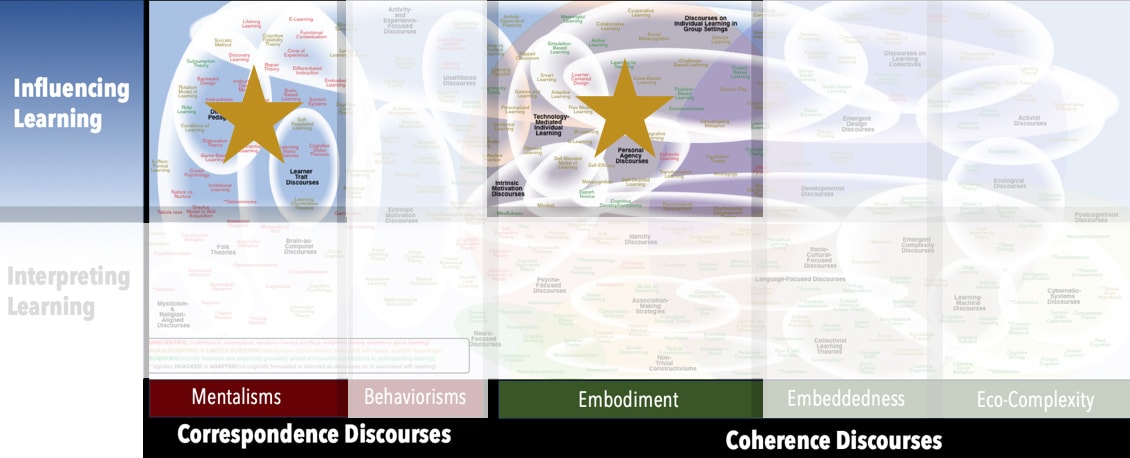AKA
Taxonomy of Educational Objectives
Focus
Differentiated and ranked modes of thinkingPrincipal Metaphors
- Knowledge is … established facts and creative possibilities based on those facts
- Knowing is … recalling (to apply, analyze, evaluate, create)
- Learner is … a student (individual)
- Learning is … remembering and understanding
- Teaching is … structuring experiences (to engage all cognitive levels)
Originated
1950sSynopsis
Bloom’s Taxonomy comprises sets of educational objectives that span three domains – cognitive, affective, and psychomotor (see below) – but often only the cognitive domain is considered. That is, most commonly, Bloom’s Taxonomy is understood as a hierarchal model of educational learning objectives that identifies distinct modes of engaging with knowledge. Originally developed in the mid-1900s, the current (2001) version comprises six subdomains: Remember, Understand, Apply, Analyze, Evaluate, Create. This list has been subject to numerous revisions and imitations since its original publication, and illustrative examples include:
- Bloom’s Twist – This phrase has emerged as a catch-all for updates to (i.e., rewordings, elaborations, and/or reformattings of Bloom’s Taxonomy.
- Revised Bloom’s Taxonomy (David Krathwohl, 2000s) – a two-dimensional model by adding a “Knowledge Dimension” (comprising four types: Factual, Conceptual, Procedural, Metacognitive) to the cognitive processes identified in Bloom’s Taxonomy, resulting in many more, finer-grained categories of consideration.
- Three-Story Intellect Model (Robert Fogarty, 1990s) – a hierarchical model of cognitive acts that’s intended to inform teaching. Its three levels can be roughly mapped onto Bloom’s Taxonomy: Gathering (akin to Bloom’s “Remember”); Processing (akin to Bloom’s “Understand”); Applying (mashing up Bloom’s “Apply,” “Analyze,” “Evaluate,” and “Create”).
- Affective Domain of Learning – concerned with emotions and attitudes, grouped into five subdomains: Receiving, Responding, Valuing, Organization, Characterization
- Cognitive Domain of Learning – concerned with knowledge and intellectual capacity, as described above
- Psychomotor Domain of Learning – concerned with physical movement and coordinated motor skills, grouped into seven subdomains: Perception, Set, Guided Response, Mechanism, Complex Overt Response, Adaptation, Origination
- Affective Education – an umbrella term that applies to any program that attends to the relations among all three domains of learning – cognitive (thoughts), affective (feelings), and psychomotor (behaviors). Popular associated constructs include:
- Hot Cognition (Robert Abelson, 1960s) – mental activity affected by emotion
- Cold Cognition (Robert Abelson, 1960s) – mental activity with not affective component (e.g., memorizing a grocery list)
- Cognitive Demand (Cognitively Demanding Instruction; Cognitively Demanding Tasks) (Margaret Schwan Smith, Mary Kay Stein, 1990s) – a descriptive reference to relative levels of analysis, application, memorization, and other mental engagements associated with an activity
Commentary
As with many popular educational taxonomies, Bloom’s Taxonomy originally lacked a systematic rationale for construction. Consequently, the model may be more an instantiation of common wisdom than a contribution to thinking. In addition, the tendency to describe the taxonomy in hierarchical terms has prompted many educators to focus on the higher levels and give limited attention to the lower – often in active ignorance of the simultaneity of such competencies in many problem-solving settings and the critical role of facts and skills in supporting creative competencies across most domains. (See Bloom’s Taxonomy of Questions, under Questions.)Authors and/or Prominent Influences
Benjamin BloomStatus as a Theory of Learning
Bloom’s Taxonomy is not a theory of learning.Status as a Theory of Teaching
Bloom’s Taxonomy is a theory of teaching – or, more descriptively, a model of learning objectives. Through the last half of the 20th century, it likely played an important role in efforts to critique and elaborate traditional, standardized educational emphases by presenting a vocabulary that helped to interrupt assumptions on the nature of learning and the aims of schooling.Status as a Scientific Theory
Bloom’s Taxonomy is not a scientific theory and was not originally based or associated with any effort to gather empirical evidence. With specific regard to theories of learning, no part of taxonomy addresses the complex dynamics of the phenomenon of learning. Some studies have been generated to show its usefulness in supporting learner achievement and attitude (in comparison to rote-based instruction).Subdiscourses:
- Affective Domain of Learning
- Affective Education
- Bloom’s Twist
- Cognitive Demand (Cognitively Demanding Instruction; Cognitively Demanding Tasks)
- Cognitive Domain of Learning
- Cold Cognition
- Hot Cognition
- Psychomotor Domain of Learning
- Revised Bloom’s Taxonomy
- Three-Story Intellect Model
Map Location

Please cite this article as:
Davis, B., & Francis, K. (2025). “Bloom’s Taxonomy” in Discourses on Learning in Education. https://learningdiscourses.com.
⇦ Back to Map
⇦ Back to List
